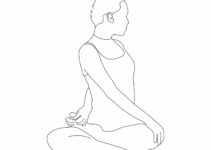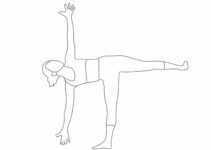What is the meaning of Uddiyana Bandha?
- Uddiyana Bandha is a Sanskrit word wherein uddiyana means ‘to raise’ or ‘to fly upwards’, and bandha means to hold’, ‘tighten’ or ‘lock’.
- It is so called because the physical lock applied to the body causes the diaphragm to rise towards the chest.
- Uddiyana bandha is a beneficial practice and integral to kriya yoga.

How to do Uddiyana bandha step by step
Uddiyana bandha looks difficult; however, it is much simpler than it seems.
- Sit comfortably in Siddhasana, Padmasana, Vajrasana or Sukhasana.
- Place both hands (palms) on the knees firmly.
- Exhale entirely through nose and mouth.
- Hold your breath out and perform Jalandharabandha.
- Pull abdominal muscles up and inside towards the spine.
- Retain the breath outside as long as one feels comfortable.
- Raise the head.
- Release the Jalandharabandha.
- Inhale slowly and release the abdominal muscles.
- Return to the normal position.
- Rest for a while before commencing the next round.
Scriptural references in Yogic texts
- Uddiyana bandha is mentioned in many scriptures such as Hatha Yoga Pradipika, the Gherand Samhita and the Baraha, Yoga Sikha, Yoga Kundalini, Dhyana Bindu, Yoga Tattva and Chudamani Upanishads.
- “The lock which causes the prana to fly up the Sushumna is called uddiyana by all yogis.” 3:55)- The Hatha Yoga Pradipika.
- “Drawing the abdomen backwards and upwards in the navel region is called uddiyana. It is the lion which challenges the elephant of death.” (3:57).
Uddiyana bandha precautions
- To practise uddiyana seriously, the diet should be good and taken in small quantities.
- During the practice, the knees should rest firmly on the ground to maintain the final lock correctly.
- Try initially to empty the lungs as much as possible by contracting the abdominal muscles and the chest.
- Make sure you apply jalandhara bandha before the final position to prevent air from entering the lungs.
- The abdominal muscles should remain passive. Contraction shouldn’t be tried in the final position.
- When you release the final pose, relax the chest, then release the Jalandhar bandha and breathe in.
- The stomach must be empty before doing this practice.
- One should do this yoga pose after eating for four to five hours.
The best position for doing Uddiyana Bandha
- The best position for doing it is padmasana, siddhasana or siddha yoni asana.
- If there are issues in sitting the asanas mentioned above, practice with vajrasana.
- Uddiyana bandha can also be done in a standing position.
Breathing
- One should do deep exhalation before taking the final position.
- Try to hold your breath outside while taking the final position.
- Inhale on completion of the practice.
- After becoming perfect in the process, try to develop an awareness of breathing.
Duration
- You can practise as many rounds as you wish without experiencing strain.
- Beginners should do only a few rounds initially and then slowly increase the number.
- The final position of each round should be held for as long as you can comfortably hold your breath.
Time of practice
- Early morning, before breakfast, is the best time to practice this kriya yoga.
- The best time to do uddiyana bandha in your practice program is after asanas and pranayama and before meditational practice. Uddiyana can also be combined with pranayama and mudras.
Uddiyana bandha contraindications
- There are certain limitations in the practice of this yoga pose.
- High blood pressure
- Heart problems
- Peptic or duodenal ulcers
- Colitis
- Serious abdominal problems
- Pregnant women should not do this practice.
Amazing benefits of Uddiyana Bandha
To gain maximum benefits from the pose, it must be done correctly.
- Regular practice makes even an old man youthful.” (3:58) Uddiyana bandha revitalises the whole body and can help to lead to states of meditation that can make even an older man feel young.
- The entire abdomen is squeezed like a sponge, pushing out all the stagnant blood. Accordingly, the inner organs are revitalised.
- It can help prevent many abdominal ailments, such as indigestion, constipation, diabetes and colitis.
- The adrenal glands are regularised, giving a lazy person energy.
- The heart is given a good massage, which improves its functional efficiency.
- The navel is the area of the Manipura chakra, which is the centre of prana in the body. Physical stimulation in this area has numerous health benefits and prevents practitioners from many diseases.






After releasing the Uddiyana bandh, one should first exhale the small amount of residual air accumulated in the lungs and then inhale to fill the lungs with a fresh amount of air.